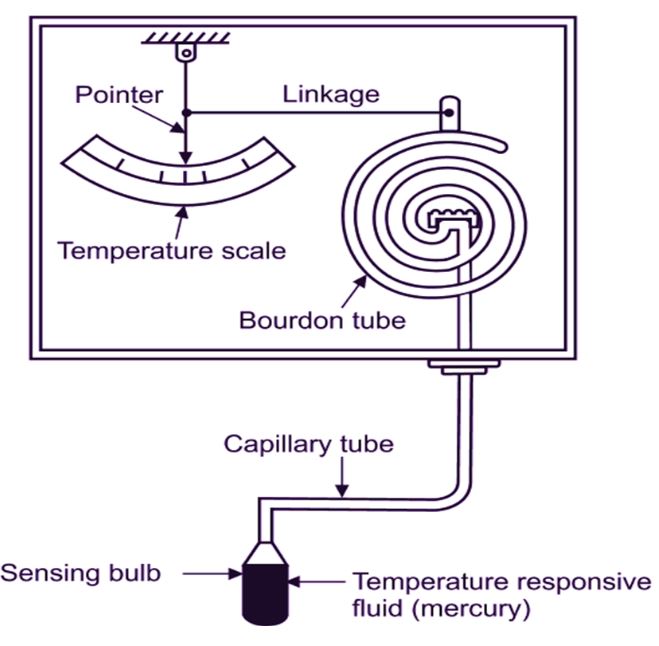Table of Contents
Method of Temperature Measurement:
Expansion of the liquid caused by a rise in temperature is the method used in pressure gauge thermometer or liquid in glass thermometer.
Working principle of Pressure Gauge Thermometer:
Liquid expands in volume as the temperature rises. The increase in liquid volume and temperature are directly proportional. Therefore, we can estimate temperature by measuring the increase in liquid volume.

Pressure Gauge Thermometer Construction:
The components of a liquid-filled thermometer or pressure gauge thermometer are:





Pressure bulb :
A sensing component called a pressure bulb that contains thermometer fluid (transmitting fluid or responsive fluid or thermometric fluid). A metal tube with a cylindrical shape called a pressure bulb. Pressure bulb has a closed one end and a capillary tube connection on the other. Wherever temperature is to be measured, pressure to be placed there.
Capillary tube:
The tube has an extremely small diameter. Copper or steel capillary tubes are used in systems that use fluids other than mercury. Stainless steel is utilised for capillary tubes where mercury is the transmitting fluid. The pressure bulb is connected to the transmission system and the readout device by a capillary tube.
Receiving component:
It is a device that reacts to changes in temperature or pressure that affect the volume of the thermometer fluid. As a receiving element, you can use a bellow, a diaphragm, or Bourdon’s pressure gauge. The changing volume or pressure of the thermometer fluid (the transmitting fluid) are converted into displacement by the receiving device. The resultant displacement can be amplified to move a pointer over a stationary scale to indicate temperature.
Working of Pressure Gauge Thermometer:
The medium whose temperature has to be measured is exposed to the sensing bulb. Pressure inside the bulb will rise or fall depending on the temperature difference between the surroundings and the medium being monitored. The bourden tube receives the signal from the fluid pressure change in the bulb. The capillary tube serves as the conduit for the pressure transmission. As a result, a change in pressure will be interpreted as a change in temperature. The Bourden tube often has an oval form before the pressure changes. It usually starts to form a circle after a pressure change. As a result, the links magnify this slight displacement, and the pointer will reflect it. The pointer’s new location on the calibration scale serves as a temperature indicator. The pointer’s new location on the calibration scale serves as a temperature indicator.
Advantage of a Pressure Gauge Thermometer:
Rigid in its design.
low price.
Good accuracy (1% of full scale)
Good sensitivity and reaction.
It is a self-operated system because it doesn’t require supplementary electricity to function.
Only auxiliary power is required for it to operate if it is paired with a pneumatic or electrical transmission system for the purpose of magnification.
decreased upkeep.
Disadvantage of a Pressure Gauge Thermometer:
Errors might happen when filling tubes and fluid.
Long transmitting capillary tubes are not a good fit for it.
The calibration may wander due to the filling fluid.
Recommended Articles:-
What is Thermocouple and its Tpyes
What are the pressure sensing elements
What is Thermometer ? What are the types of Thermometer ?